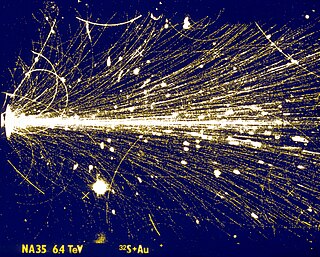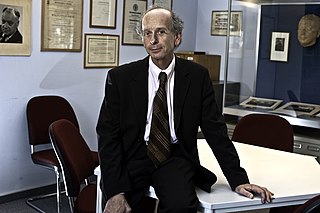
In modern physics, antimatter is defined as matter composed of the antiparticles of the corresponding particles in "ordinary" matter, and can be thought of as matter with reversed charge, parity, and time, known as CPT reversal. Antimatter occurs in natural processes like cosmic ray collisions and some types of radioactive decay, but only a tiny fraction of these have successfully been bound together in experiments to form antiatoms. Minuscule numbers of antiparticles can be generated at particle accelerators; however, total artificial production has been only a few nanograms. No macroscopic amount of antimatter has ever been assembled due to the extreme cost and difficulty of production and handling. Nonetheless, antimatter is an essential component of widely available applications related to beta decay, such as positron emission tomography, radiation therapy, and industrial imaging.

The European Organization for Nuclear Research, known as CERN, is an intergovernmental organization that operates the largest particle physics laboratory in the world. Established in 1954, it is based in Meyrin, western suburb of Geneva, on the France–Switzerland border. It comprises 24 member states. Israel, admitted in 2013, is the only non-European full member. CERN is an official United Nations General Assembly observer.

Antihydrogen is the antimatter counterpart of hydrogen. Whereas the common hydrogen atom is composed of an electron and proton, the antihydrogen atom is made up of a positron and antiproton. Scientists hope that studying antihydrogen may shed light on the question of why there is more matter than antimatter in the observable universe, known as the baryon asymmetry problem. Antihydrogen is produced artificially in particle accelerators.
ATHENA, also known as the AD-1 experiment, was an antimatter research project at the Antiproton Decelerator at CERN, Geneva. In August 2002, it was the first experiment to produce 50,000 low-energy antihydrogen atoms, as reported in Nature. In 2005, ATHENA was disbanded and many of the former members of the research team worked on the subsequent ALPHA experiment and AEgIS experiment.
This is a timeline of subatomic particle discoveries, including all particles thus far discovered which appear to be elementary given the best available evidence. It also includes the discovery of composite particles and antiparticles that were of particular historical importance.

Dimitri V. Nanopoulos is a Greek physicist. He is one of the most regularly cited researchers in the world, cited more than 48,500 times across a number of separate branches of science.

The gravitational interaction of antimatter with matter or antimatter has been observed by physicists. As was the consensus among physicists previously, it was experimentally confirmed that gravity attracts both matter and antimatter at the same rate within experimental error.

The PS210 experiment was the first experiment that led to the observation of antihydrogen atoms produced at the Low Energy Antiproton Ring (LEAR) at CERN in 1995. The antihydrogen atoms were produced in flight and moved at nearly the speed of light. They made unique electrical signals in detectors that destroyed them almost immediately after they formed by matter–antimatter annihilation.

The Antiproton Decelerator (AD) is a storage ring at the CERN laboratory near Geneva. It was built from the Antiproton Collector (AC) to be a successor to the Low Energy Antiproton Ring (LEAR) and started operation in the year 2000. Antiprotons are created by impinging a proton beam from the Proton Synchrotron on a metal target. The AD decelerates the resultant antiprotons to an energy of 5.3 MeV, which are then ejected to one of several connected experiments.

The Low Energy Anti-Proton Ring (LEAR) was a particle accelerator at CERN which operated from 1982 until 1996. The ring was designed to decelerate and store antiprotons, to study the properties of antimatter and to create atoms of antihydrogen. Antiprotons for the ring were created by the CERN Proton Synchrotron via the Antiproton Collector and the Antiproton Accumulator (AA). The creation of at least nine atoms of antihydrogen were confirmed by the PS210 experiment in 1995.

Fermilab E-906/SeaQuest is a particle physics experiment which will use Drell–Yan process to measure the contributions of antiquarks to the structure of the proton or neutron and how this structure is modified when the proton or neutron is included within an atomic nucleus.

The NA35 experiment was a particle physics experiment that took place in the North Area of the Super Proton Synchrotron (SPS) at CERN. It used a streamer chamber with comprehensive hadronic and electromagnetic calorimetry. This experiment was used to observe the properties of nucleus-nucleus collisions at 60 and 200 GeV/nucleon, to understand the degree of stopping and thermalization, determine the energy densities achievable in those conditions, and to measure other related properties and quantities.
Erwin Gabathuler was a particle physicist from Northern Ireland.

The Antihydrogen Laser Physics Apparatus (ALPHA), also known as AD-5, is an experiment at CERN's Antiproton Decelerator, designed to trap antihydrogen in a magnetic trap in order to study its atomic spectra. The ultimate goal of the experiment is to test CPT symmetry through comparing the respective spectra of hydrogen and antihydrogen. Scientists taking part in ALPHA include former members of the ATHENA experiment (AD-1), the first to produce cold antihydrogen in 2002.
AEgIS, AD-6, is an experiment at the Antiproton Decelerator facility at CERN. Its primary goal is to measure directly the effect of Earth's gravitational field on antihydrogen atoms with significant precision. Indirect bounds that assume the validity of, for example, the universality of free fall, the Weak Equivalence Principle or CPT symmetry also in the case of antimatter constrain an anomalous gravitational behavior to a level where only precision measurements can provide answers. Vice versa, antimatter experiments with sufficient precision are essential to validate these fundamental assumptions. AEgIS was originally proposed in 2007. Construction of the main apparatus was completed in 2012. Since 2014, two laser systems with tunable wavelengths and synchronized to the nanosecond for specific atomic excitation have been successfully commissioned.

Michel Spiro is a French physicist.

John Holmes Malmberg was an American plasma physicist and a professor at the University of California, San Diego. He was known for making the first experimental measurements of Landau damping of plasma waves in 1964, as well as for his research on non-neutral plasmas and the development of the Penning–Malmberg trap.

Stefan Ulmer is a particle physicist, professor of Physics at Heinrich Heine University Düsseldorf and chief scientist at the Ulmer Fundamental Symmetries Laboratory, RIKEN, Tokyo. He is the founder and the spokesperson of the BASE experiment (AD-8) at the Antiproton Decelerator facility at CERN, Geneva. Stefan Ulmer is well known for his contributions to improving Penning trap techniques and precision measurements on antimatter. He is the first person to observe spin transitions with a single trapped proton as well as single spin transitions with a single trapped antiproton, a significant achievement towards a precision measurement of the antiproton magnetic moment.
Felix Hans Boehm was a Swiss-American experimental physicist, known for his research on weak interactions, parity violation, and neutrino physics.

The COLinear LAser SPectroscopy (COLLAPS) experiment is located in the ISOLDE facility at CERN. The purpose of the experiment is to investigate ground and isomeric state properties of exotic, short lived nuclei, including spins, electro-magnetic moments and charge radii. The experiment has been operating since the late 1970s, and is the oldest active experiment at ISOLDE.















